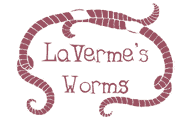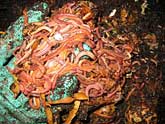 |
 |
|
ellensandbeck.com Green Barbarians–Ellen Sandbeck  A Buddha A Day–Ellen Sandbeck   |
Vermicomposting at the Lake Superior ZooThe outdoor vermicomposting site was started in Spring of 1999 by Lake Superior zookeepers and worm consultant Ellen Sandbeck. A 40-foot-long, 7- or 8-foot tall pile of straw bedding, spilled feed, and manure form the hoofed mammals was innoculated with ten gallons of red wriggler womrs (Eisenia fetida). Then each participant crossed her fingers, hoping that the worms would be able to find each other in the enormous pile. The pile was re-innoculated with five gallons of worms twice more during the summer. In the fall, the pile, which had decreased dramatically, was heaped up by a Bobcat front-end loader, in order to ensure enough mass to prevent the pile from freezing solid over the winter. The next spring worms had colonized the entire pile. The zoo vermicomposting pile now handles 20-25 bales of straw per week in the winter, and approximately 15 bales of straw per week in the summer, along with manure, spilled feed, and some yard waste. Vermicomposting is an extremely efficient method of composting, which requires very little work once it is going. The worms do the aerating, so there is no need to turn even very large piles; the worms eat the organic waste, and the waste the worms produce is an extremely valuable fertilizer known as "worm castings." Nutrients are rendered more accessible to plants after they have passed through an earthworm's gut; worm compost is therefore much richer than regular compost, and should be used more like a fertilizer, just sprinkled on the surface of the ground, rather than used inches deep as one would use garden variety compost. The "zoo doo" vermicompost you have just bought will be much appreciated by your plants, but must be used sparingly. Vermicompost is wonderful for most plants, but must be kept away from peas and beans, as it is much too rich for them, and will prevent them from setting a crop. You will probably notice live red wrigglers in your vermicompost. The worms will live happily in your garden as long as the temperature is above freezing. After that, they will become fertilizer for next year. Vermicompost and worms can also be added to a home compost pile in order to speed it up.
|
|
|